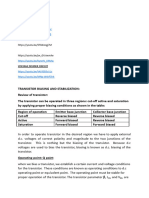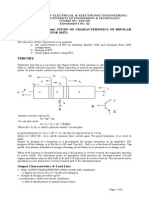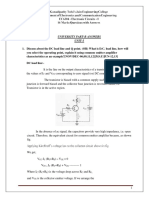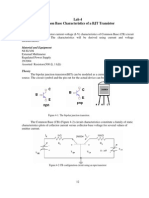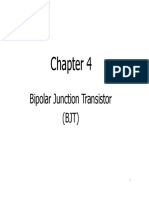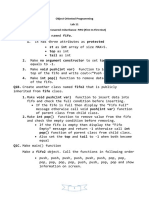LAB 3-PE-Lab
Uploaded by
Lovely JuttLAB 3-PE-Lab
Uploaded by
Lovely JuttInternational Islamic University Islamabad
Faculty of Engineering & Technology
Department of Electrical Engineering
POWER ELECTRONICS LAB (EE421L)
Experiment No. 3: Switching Characteristics of Power BJT
Name of Student: ……………………………………
Registration No.: ……………………………………..
Date of Experiment: …………………………………
Submitted To: ………………………………………,..
Experiment No. 3: Switching Characteristics of Power BJT Page 1
Objectives:
To study the basic properties of the power BJT.
To demonstrate the different regions of operation of power BJT.
To plot the output characteristics of the power BJT.
Equipment Required:
DMM
DC Power Supply: +24V(variable); +5V (fixed);
NPN Power BJT: TIP31 [Qty=1];
Resistor: 22-kΩ/1W [Qty=1];
Power Resistor: 1-kΩ /5W [Qty=1];
Potentiometer: 5-kΩ [Qty=1];
Connecting wires
Theory:
Power transistors are devices that have controlled turn-ON and turn-OFF
characteristics. They are turned ON, when a current signal is given to base or control. The
transistor remains ON as long as the control signal is present. The switching speed of modern
transistors is much higher than that of Thyristors and they are extensively employed in DC-
to-DC and DC-to-AC converters. However, their voltage and current ratings are lower than
those of Thyristors and are therefore they are used in low to medium power applications. The
power Bipolar Junction Transistor (BJT) is a current controlled device and it has three
terminals: Collector (C), Emitter (E) and Base (B). There are two types of power
BJTs; NPN and PNP transistor as given in Figure 3.1(a) and 3.1(b) respectively. NPN
transistor is widely used as compared to PNP transistor.
Power BJT has a vertically oriented four-layer structure. The vertical structure
increases the cross-sectional area. The first layer is a heavily doped emitter layer (n+). The
second layer is moderately doped the base layer (p). The third region is lightly
doped collector drift region (n-). The last layer is a highly doped collector region (n+). The
drift layer (n-) increase the voltage blocking capacity of the transistor due to the low doping
level. The width of this layer decides the breakdown voltage. The disadvantage of this layer
is that, it increases the ON-state voltage drops, which increases power losses. The power BJT
blocks a high voltage in the OFF-state and high current carrying capacity in the ON-state. In
the structure of a BJT, there are two junctions; base-emitter (BE) and collector-base (CB)
junction respectively.
Experiment No. 3: Switching Characteristics of Power BJT Page 2
Figure 3.1(a): NPN Bipolar Junction Transistor Figure 3.1(b): PNP Bipolar Junction Transistor
There are four regions of operation of a power BJT (cutoff, active, quasi-saturation
and hard-saturation region) as demonstrated in Figure 3.2.
Figure 3.2 Expected Output Characteristics of a Power BJT
i. Cutoff region:
When the base current (IB) is zero, the collector current (IC) is insignificant and the
transistor is driven into the cutoff region. The transistor will be in OFF state and a very small
reverse leakage current (IC = ICEO) flows through the collector. The collector-base (CB) and
base-emitter (BE) both junctions are reverse biased in cutoff region, and the transistor
behaves as an open switch.
Experiment No. 3: Switching Characteristics of Power BJT Page 3
ii. Active region:
The BE junction is forward biased and CB junction is reverse biased. The collector
current (IC) increase slightly with an increase in collector-emitter voltage (VCE) if base
current (IB) is increased. The relation of IB and IC is: IC = βdc IB is true in the active region. In
this region, BJT is used as an amplifier or as a series pass transistor in the voltage regulator.
The dynamic resistance in this region is large. The power dissipation is maximum.
iii. Quasi-saturation region:
Quasi-saturation region is between the hard saturation and active region. This region
exists due to the lightly doped drift layer. When the BJT operates at high frequency, it is
operated in this region. Both junctions are forward biased. The device offers low resistance
compared to the active region. Therefore, power loss is less. In this region, the device does
not go into deep saturation. Therefore, it can turn OFF quickly. That is why; we can use
power BJT for higher frequency applications. Remember, this feature is not found in small
signal transistor.
iv. Hard-saturation region:
The power BJT pushes into the hard-saturation region from the quasi-saturation
region by increasing the base current. This region is also known as deep saturation region.
The resistance offers in this region is minimum. It is even less than the quasi-saturation
region. Therefore, when the BJT operates in this region, power dissipation is minimum. The
device acts as a closed switch when it operates in this region. However, it needs more time to
turn OFF. Therefore, this region is suitable only for low-frequency switching application. In
this region, both junctions are forward biased. The collector current is not proportional to the
base current, IC remains almost constant at IC (sat) and independent of base current.
Key Points:
In power handling and control purposes, power BJT is generally used in cutoff for OFF state
and quasi-saturation for ON state to act as a switch. This switching is very quick that results
in low voltage drops which is desired characteristic for power electronics components.
Applications of Power BJT:
i. Switch mode power supply (SMPS) commonly used in computers.
ii. Final audio amplifier in stereo systems.
iii. Power amplifiers.
iv. DC to AC inverters.
v. Relay and display drivers.
vi. AC motor speed controllers.
Experiment No. 3: Switching Characteristics of Power BJT Page 4
Procedure:
a. Identify the base, emitter and collector terminal of the power BJT.
b. Construct the circuit of Figure 3.3 on the breadboard. Measure and record the value of
base and collector resistor using DMM.
RB (measured) =__________________
RC (measured) =__________________
Figure 3.3
c. Apply VCC = 12V to the circuit of Figure 3.3, and set the potentiometer (Pot-1) such that
the base current (IB) is equal to 0-uA.
d. Now, vary the supply voltage (VCC) in steps as mentioned in Table 3.1 and record the
𝐕𝐑𝐂
values of collector-emitter voltage (VCE) and the collector current (IC = ) at each step
𝐑𝐂
to fill the Table 3.1.
Note: Measure the voltage across the collector resistor (VRC) using smallest possible
scale of voltmeter, because BJT will be in cutoff region, when IB = 0-uA, and very
minimum current will flow through the collector resistor.
Table 3.1 (For IB = 0-uA)
VCC 0V 2V 4V 6V 8V 10V 12V 14V 16V 18V 20V
(measured)
VCE
(measured)
VRC
(measured)
𝐕𝐑𝐂
IC =
𝐑𝐂
(measured)
Experiment No. 3: Switching Characteristics of Power BJT Page 5
e. Set the base current (IB) to 40-uA value by varying the potentiometer (Pot-1).
Note: Measure the base current using smallest possible scale of ammeter. In the absence
of ammeter, you can set the IB = 40-uA, by setting the voltage across the base resistor
(VRB) to nearly 0.88V.
f. Now, vary the supply voltage (VCC) in steps as mentioned in Table 3.2 and record the
𝐕𝐑𝐂
values of collector-emitter voltage (VCE) and the collector current (IC = ) at each step
𝐑𝐂
to fill the Table 3.2.
Table 3.2 (For IB = 40-uA)
VCC
0V 2V 4V 6V 8V 10V 12V 14V 16V 18V 20V
(measured)
VCE
(measured)
VRC
(measured)
𝐕𝐑𝐂
IC =
𝐑𝐂
(measured)
g. Again, set the base current (IB) to 80-uA value by varying the potentiometer (Pot-1).
Note: Measure the base current using smallest possible scale of ammeter. In the absence
of ammeter, you can set the IB = 80-uA, by setting the voltage across the base resistor
(VRB) to nearly 1.76V.
h. Now, vary the supply voltage (VCC) in steps as mentioned in Table 3.3 and record the
𝐕𝐑𝐂
values of collector-emitter voltage (VCE) and the collector current (IC = ) at each step
𝐑𝐂
to fill the Table 3.3.
Table 3.3 (For IB = 80-uA)
VCC 0V 2V 4V 6V 8V 10V 12V 14V 16V 18V 20V
(measured)
VCE
(measured)
VRC
(measured)
𝐕𝐑𝐂
IC =
𝐑𝐂
(measured)
Experiment No. 3: Switching Characteristics of Power BJT Page 6
i. Again, set the base current (IB) to 120-uA value by varying the potentiometer (Pot-1).
Note: Measure the base current using smallest possible scale of ammeter. In the absence
of ammeter, you can set the IB = 120-uA, by setting the voltage across the base resistor
(VRB) to nearly 2.64V.
j. Now, vary the supply voltage (VCC) in steps as mentioned in Table 3.4 and record the
𝐕𝐑𝐂
values of collector-emitter voltage (VCE) and the collector current (IC = ) at each step
𝐑𝐂
to fill the Table 3.4.
Table 3.4 (For IB = 120-uA)
VCC
0V 2V 4V 6V 8V 10V 12V 14V 16V 18V 20V
(measured)
VCE
(measured)
VRC
(measured)
𝐕𝐑𝐂
IC =
𝐑𝐂
(measured)
k. Again, set the base current (IB) to 160-uA value by varying the potentiometer (Pot-1).
Note: Measure the base current using smallest possible scale of ammeter. In the absence
of ammeter, you can set the IB = 160-uA, by setting the voltage across the base resistor
(VRB) to nearly 3.52V.
l. Now, vary the supply voltage (VCC) in steps as mentioned in Table 3.5 and record the
𝐕𝐑𝐂
values of collector-emitter voltage (VCE) and the collector current (IC = ) at each step
𝐑𝐂
to fill the Table 3.5.
Table 3.5 (For IB = 160-uA)
VCC 0V 2V 4V 6V 8V 10V 12V 14V 16V 18V 20V
(measured)
VCE
(measured)
VRC
(measured)
𝐕𝐑𝐂
IC =
𝐑𝐂
(measured)
Experiment No. 3: Switching Characteristics of Power BJT Page 7
Sketching of Switching Characteristics:
Using the data of Table 3.1, 3.2, 3.3, 3.4 and 3.5, draw the switching characteristics
curves of the power BJT on Figure 3.4.
Figure 3.4: Switching Characteristics of Power BJT
Experiment No. 3: Switching Characteristics of Power BJT Page 8
You might also like
- 9 Ways BMC Helix Itsm Beats The Competition 2No ratings yet9 Ways BMC Helix Itsm Beats The Competition 213 pages
- Course: Electronic Circuit Devices Lab No: 02 Title: Bipolar Junction Transistor DC Response. CID: - DateNo ratings yetCourse: Electronic Circuit Devices Lab No: 02 Title: Bipolar Junction Transistor DC Response. CID: - Date6 pages
- Analogue Electronic Design Module E EEE2039 / EEE2026 / EEE2042100% (1)Analogue Electronic Design Module E EEE2039 / EEE2026 / EEE204236 pages
- Experiment 3 (A) To Study Bipolar Junction Transistor (BJT) Emitter Bias Configuration and Its StabilityNo ratings yetExperiment 3 (A) To Study Bipolar Junction Transistor (BJT) Emitter Bias Configuration and Its Stability14 pages
- 1.0 Objectives: Bipolar Junction Transistor CharacteristicsNo ratings yet1.0 Objectives: Bipolar Junction Transistor Characteristics3 pages
- 3-Transistor Characteristics and Amplifier CircuitsNo ratings yet3-Transistor Characteristics and Amplifier Circuits11 pages
- Unit Ibiasing of Discrete BJT and MosfetNo ratings yetUnit Ibiasing of Discrete BJT and Mosfet57 pages
- Lab6 Bipolar Junction Transistor Characteristics1588857204No ratings yetLab6 Bipolar Junction Transistor Characteristics15888572044 pages
- Simulation of BJT Amplifier: Course - Section: ECE20L-E06 Group NumberNo ratings yetSimulation of BJT Amplifier: Course - Section: ECE20L-E06 Group Number10 pages
- Experiment 11: NPN BJT Common Emitter Characteristics100% (1)Experiment 11: NPN BJT Common Emitter Characteristics7 pages
- Course: Electronic Circuit Devices Lab No: 0 Title: Bipolar Junction Transistor Characteristic Curves. CID: - DateNo ratings yetCourse: Electronic Circuit Devices Lab No: 0 Title: Bipolar Junction Transistor Characteristic Curves. CID: - Date4 pages
- ET 212 Electronics: Bipolar Junction Transistors100% (1)ET 212 Electronics: Bipolar Junction Transistors29 pages
- ECD Skill-Based-Mini-Project (1) - RemovedNo ratings yetECD Skill-Based-Mini-Project (1) - Removed12 pages
- Satyam Kr. Tiwari, Roll 99, BJT EMITTER Assignment 3No ratings yetSatyam Kr. Tiwari, Roll 99, BJT EMITTER Assignment 311 pages
- Experiment 3: Common Emitter CharacteristicsNo ratings yetExperiment 3: Common Emitter Characteristics6 pages
- Engg. Physics Lab Manual Transistor Characterics SL No 10No ratings yetEngg. Physics Lab Manual Transistor Characterics SL No 103 pages
- Fundamentals of Electronics 1: Electronic Components and Elementary FunctionsFrom EverandFundamentals of Electronics 1: Electronic Components and Elementary FunctionsNo ratings yet
- Publication That Stores The Title (A Char Array) and PriceNo ratings yetPublication That Stores The Title (A Char Array) and Price1 page
- Object Oriented Programming Lab 03 Topic Covered: Constructor and DestructorNo ratings yetObject Oriented Programming Lab 03 Topic Covered: Constructor and Destructor2 pages
- Object Oriented Programming Lab 01 Topic Covered: Classes and ObjectsNo ratings yetObject Oriented Programming Lab 01 Topic Covered: Classes and Objects2 pages
- Object Oriented Programming Lab 11 Topic Covered: Inheritance FIFO (First in First Out)No ratings yetObject Oriented Programming Lab 11 Topic Covered: Inheritance FIFO (First in First Out)1 page
- Unit-1 - Technology of Meat, Fish, Poultry & Their ProductsNo ratings yetUnit-1 - Technology of Meat, Fish, Poultry & Their Products11 pages
- Buried Bodies Detection Using Ground Penetrating RADARNo ratings yetBuried Bodies Detection Using Ground Penetrating RADAR6 pages
- Frictionless Spacecraft Simulator With Unrestricted Three Axis Movement For NanosatsNo ratings yetFrictionless Spacecraft Simulator With Unrestricted Three Axis Movement For Nanosats12 pages
- He Who Has Never Learned To Obey Cannot Be A GoodNo ratings yetHe Who Has Never Learned To Obey Cannot Be A Good4 pages
- 4 - 10-21-2022 - 10-26-38 - Bachelor of Arts (First To Sixth Semester)No ratings yet4 - 10-21-2022 - 10-26-38 - Bachelor of Arts (First To Sixth Semester)68 pages
- Pressure Relief Valves ARE: Direct Operated, in Line Mounting - G 1/4" and G 1/2" Threaded PortsNo ratings yetPressure Relief Valves ARE: Direct Operated, in Line Mounting - G 1/4" and G 1/2" Threaded Ports4 pages
- Aligarh Muslim University Malappuram Centre: End-Term AssignmentNo ratings yetAligarh Muslim University Malappuram Centre: End-Term Assignment13 pages
- Course: Electronic Circuit Devices Lab No: 02 Title: Bipolar Junction Transistor DC Response. CID: - DateCourse: Electronic Circuit Devices Lab No: 02 Title: Bipolar Junction Transistor DC Response. CID: - Date
- Analogue Electronic Design Module E EEE2039 / EEE2026 / EEE2042Analogue Electronic Design Module E EEE2039 / EEE2026 / EEE2042
- Experiment 3 (A) To Study Bipolar Junction Transistor (BJT) Emitter Bias Configuration and Its StabilityExperiment 3 (A) To Study Bipolar Junction Transistor (BJT) Emitter Bias Configuration and Its Stability
- 1.0 Objectives: Bipolar Junction Transistor Characteristics1.0 Objectives: Bipolar Junction Transistor Characteristics
- 3-Transistor Characteristics and Amplifier Circuits3-Transistor Characteristics and Amplifier Circuits
- Lab6 Bipolar Junction Transistor Characteristics1588857204Lab6 Bipolar Junction Transistor Characteristics1588857204
- Simulation of BJT Amplifier: Course - Section: ECE20L-E06 Group NumberSimulation of BJT Amplifier: Course - Section: ECE20L-E06 Group Number
- Experiment 11: NPN BJT Common Emitter CharacteristicsExperiment 11: NPN BJT Common Emitter Characteristics
- Course: Electronic Circuit Devices Lab No: 0 Title: Bipolar Junction Transistor Characteristic Curves. CID: - DateCourse: Electronic Circuit Devices Lab No: 0 Title: Bipolar Junction Transistor Characteristic Curves. CID: - Date
- Satyam Kr. Tiwari, Roll 99, BJT EMITTER Assignment 3Satyam Kr. Tiwari, Roll 99, BJT EMITTER Assignment 3
- Engg. Physics Lab Manual Transistor Characterics SL No 10Engg. Physics Lab Manual Transistor Characterics SL No 10
- Fundamentals of Electronics 1: Electronic Components and Elementary FunctionsFrom EverandFundamentals of Electronics 1: Electronic Components and Elementary Functions
- Publication That Stores The Title (A Char Array) and PricePublication That Stores The Title (A Char Array) and Price
- Object Oriented Programming Lab 03 Topic Covered: Constructor and DestructorObject Oriented Programming Lab 03 Topic Covered: Constructor and Destructor
- Object Oriented Programming Lab 01 Topic Covered: Classes and ObjectsObject Oriented Programming Lab 01 Topic Covered: Classes and Objects
- Object Oriented Programming Lab 11 Topic Covered: Inheritance FIFO (First in First Out)Object Oriented Programming Lab 11 Topic Covered: Inheritance FIFO (First in First Out)
- Unit-1 - Technology of Meat, Fish, Poultry & Their ProductsUnit-1 - Technology of Meat, Fish, Poultry & Their Products
- Buried Bodies Detection Using Ground Penetrating RADARBuried Bodies Detection Using Ground Penetrating RADAR
- Frictionless Spacecraft Simulator With Unrestricted Three Axis Movement For NanosatsFrictionless Spacecraft Simulator With Unrestricted Three Axis Movement For Nanosats
- 4 - 10-21-2022 - 10-26-38 - Bachelor of Arts (First To Sixth Semester)4 - 10-21-2022 - 10-26-38 - Bachelor of Arts (First To Sixth Semester)
- Pressure Relief Valves ARE: Direct Operated, in Line Mounting - G 1/4" and G 1/2" Threaded PortsPressure Relief Valves ARE: Direct Operated, in Line Mounting - G 1/4" and G 1/2" Threaded Ports
- Aligarh Muslim University Malappuram Centre: End-Term AssignmentAligarh Muslim University Malappuram Centre: End-Term Assignment










